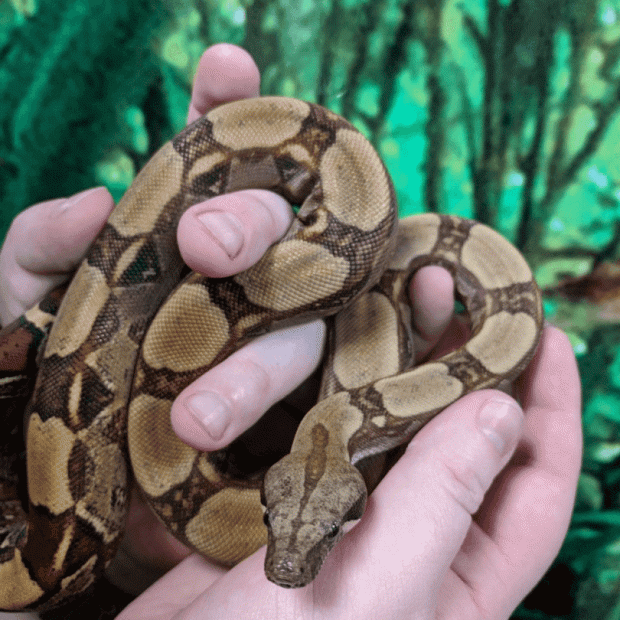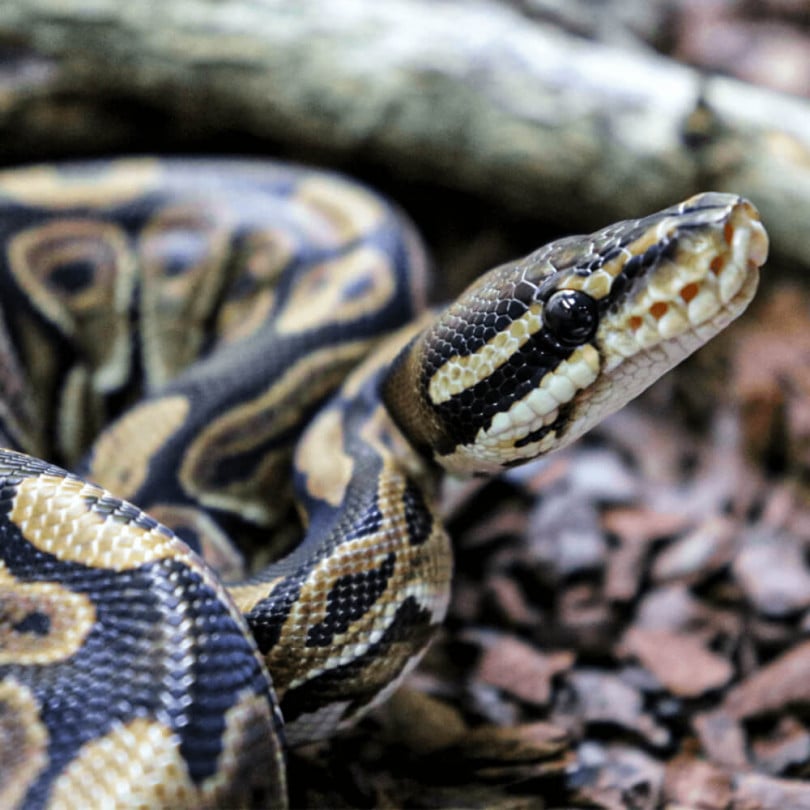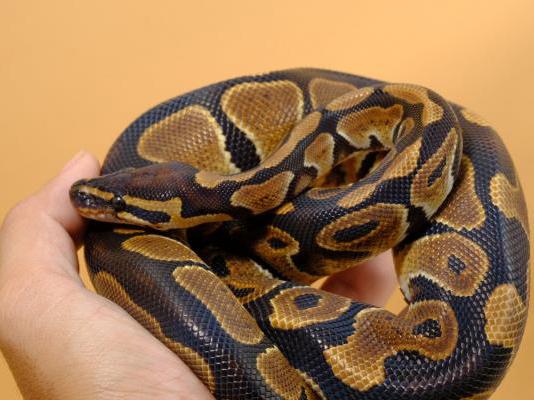-
Categories: Care sheetsSnakes
Royal python, Python regius, care sheet
Royal python, Python regius, husbandry guide from the experts at Swell Reptiles, covering housing, heating, lighting and more.
- Royal pythons make a great first snake for beginners
- Easy to handle thanks to their docile temperament
- Stunning markings and a range of colours available
Do Royal pythons make good pets?
Royal pythons make great pets regardless of your experience level. They are relatively docile animals and when you couple this with the vast range of morphs on the market, there is a Ball python out there to suit everybody’s tastes. Due to their cool, calm and collected nature, Royals are very easy to handle and won’t mind you fiddling around inside their enclosure while they are in there, however, this can also be their downfall, as they can become easily stressed and go off their food, sometimes for weeks. Potential keepers should not allow this to put them off, but it is definitely worth keeping in mind when handling, especially if the snake is new and still settling in. Ball pythons will also become stressed if kept with other Ball pythons, so this species should always be kept alone.
What size vivarium will I need for my Royal python?
Ball pythons are medium-sized snakes, with males growing to around 120cm (4ft) and females around 150cm (5ft) in length, and are quite heavy-bodied compared with other popular examples of similar lengths. They spend a lot of their time hiding away in caves and holes but will enjoy coming out to explore during the night, so a good-sized enclosure with plenty of enrichment is vital.
The minimum size for an adult Royal python enclosure should be around 120 x 60 x 60cm (4 x 2 x 2ft), with a perfect example being the VivExotic Repti-Home (AAL) Vivarium Medium Oak, not only does this give them the length they require, but a good bit of height too for climbing branches and other enrichment. To make things easier, why not view our range of Royal python starter kits.
How should I heat my Royal python vivarium?
As with any snake, Ball pythons require a temperature gradient from one side of their enclosure to the other, with the ideal hot-spot temperature being 30-32°C (86-89°F) and the cool end in the mid-twenties. This is most easily achieved using a heat bulb hooked up to a dimming thermostat, it is also important to ensure this is covered by a heat guard to protect your snake if they climb up too high.
In most homes, Royal pythons will not require any additional heating during the night, but if your home drops below around 15°C (59°F), the addition of a non-light emitting heat source such as a ceramic heat emitter may be required (this must be used in conjunction with a compatible thermostat such as a Pulse Thermostat).
An accurate thermometer is also a necessity here, to ensure the temperatures are as they should be and to identify any issues with this before it is too late, something like the Swell Digital Thermal Hygrometer is a perfect choice.
Do Royal pythons need UV lighting?
Royal pythons will benefit from a low-level UVB which should be tailored to the distance between the light and your snakes highest basking point, if this is between 25-38cm (10-15”) then the Arcadia ShadeDweller Max is a good choice, anything higher than this and you would require the Arcadia ProT5 Kit - Forest 6%, providing the light is no higher than 45cm (18”) from the highest basking point.
Which substrate is best for Royal pythons?
Once you have your heating and lighting in the bag, you will need to decide on an appropriate substrate. At Swell Reptiles we recommend soil-based substrates that hold humidity well for Ball pythons, to keep the humidity at the ideal level of around 60%, this can be something as simple as coco soil or Arcadia EarthMix for more complex bioactive set-ups.
If opting for a bioactive Royal Python set-up, you may also wish to add a drainage layer of Hydro Rocks and Hydro Matting to prevent the soil from becoming waterlogged and rotting the roots of your beloved plants.
How do I decorate a Ball python’s vivarium?
To create the perfect environment for your new Ball python, lots of cover and hides are particularly important. We recommend the use of at least two hiding caves, one in the warm end and one in the cool end of the enclosure, to ensure your snake can feel safe regardless of its current body temperature.
As Royal pythons can grow to a good size, a large or extra-large hide such as the Exo Terra Reptile Cave would be required for an adult to fit comfortably. Your Ball python won’t care what the hide looks like, so this is a good opportunity to get creative. An appropriately sized water bowl such as the Exo Terra Water Dish is also important, the general rule is that this should be large enough for your snake to soak in if they wish, especially useful when the snake is about to shed.
Royal pythons will also benefit from enrichment in the form of branches such as the Exo Terra Forest Branch to climb up, wrap around and explore. It is important, however, to ensure any branches are secured enough to take the weight of these heavy-bodied snakes to avoid accidents. Being quite a shy species, your new Ball python will thank you for adding lots of cover to their enclosure which aside from hiding caves, can be achieved by the careful placement of live or artificial plants such as our Swell Trailing Abutilon.
What do Royal pythons eat and drink?
Royal pythons are carnivorous and should be fed a diet primarily made up of frozen rodents. We recommend a mixed diet of frozen rats and frozen Multimammates, always ensuring the selected size is appropriate for your snake, generally, you do not want the food option to be any wider than the widest part of the snake’s body.
In nature, Ball pythons often prey on frozen gerbils which are becoming more readily available as a feeder option and are a great option for pickier eaters. For hatchlings and juveniles, weekly feeding is ideal, although as the snake matures you may need to extend this to every 10-14 days depending on how well the snake holds weight.
Ball pythons are not too fussy with their drinking water, as long as you provide them with a dish of clean water, they will use this to keep hydrated by both drinking and soaking as required.
How do I buy a Royal python?
All of our livestock is for in-store collection only, so if you are interested in one of our Royal pythons, please come and see us in person.
To help us ensure our livestock only goes to good homes, we will ask you to show us some images of your set-up, showing both the correct temperatures and lighting, and perform a short interview to assess your suitability to care for the animal. We reserve the right to refuse adoption to anyone we feel is unprepared to adopt.
For more detailed husbandry information regarding this wonderful snake for sale, please see our dedicated Royal Python Care Sheet. Or, you can check out some of the alternatives to the Royal python, like the Amazon tree boa.
| Common names | Royal python, Ball python |
| Scientific name | Python regius |
| Country | Africa |
| Captive-bred | Yes |
| Adult size | Males 120cm (4ft), Females 150cm (5ft) |
| Natural habitat | Sub-Saharan savannahs and grassland |
| Housing | 120cm x 60cm x 60cm (4ft x 2ft x 2ft) vivarium |
| Ideal temperature | 30-32°C (86-89°F) (basking spot/warm end); 24°C (75°F) (cool end) |
| UVI | 2-3 |
| Ideal humidity | 60% |
| Diet | Frozen rodents (rats, multimammates) |
| Average lifespan | 20-30 years |
| Personality | Docile, rarely defensive |
| Ease of handling | Easy |
| Cohabitable | No |
-
 Coastal carpet python, Morelia spilota mcdowelliFrom £120.00Out of stock
Coastal carpet python, Morelia spilota mcdowelliFrom £120.00Out of stock -
 Common boa, Boa constrictor imperatorFrom £75.00Out of stock
Common boa, Boa constrictor imperatorFrom £75.00Out of stock -
 Kenyan sand boa, Gongylophis colubrinusFrom £95.00 Regular Price £100.00 Save £5.00Out of stock
Kenyan sand boa, Gongylophis colubrinusFrom £95.00 Regular Price £100.00 Save £5.00Out of stock -
 Amazon tree boa, Corallus hortulanaFrom £270.00Out of stock
Amazon tree boa, Corallus hortulanaFrom £270.00Out of stock









